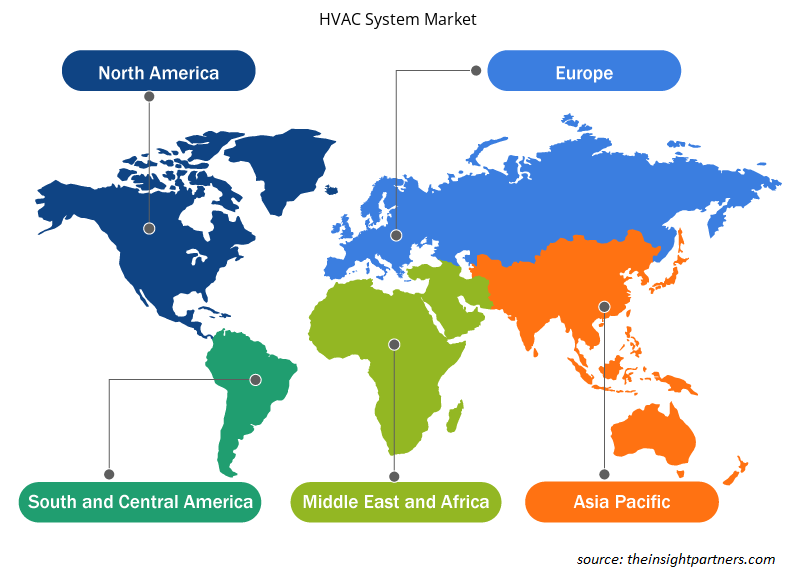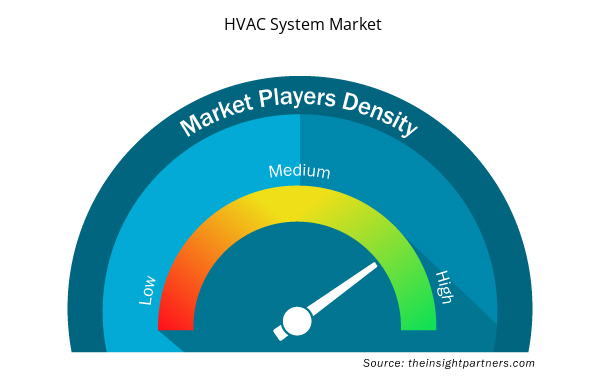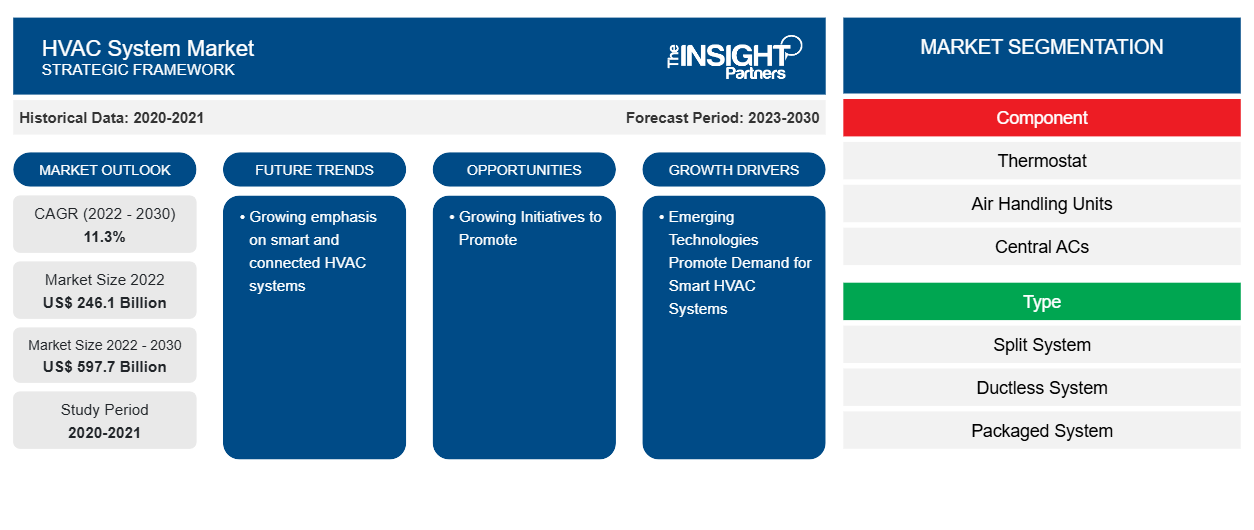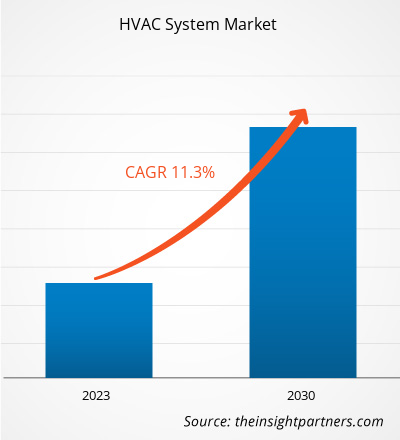من المتوقع أن ينمو حجم سوق أنظمة التدفئة والتهوية وتكييف الهواء من 246.10 مليار دولار أمريكي في عام 2022 إلى 597.7 مليار دولار أمريكي بحلول عام 2030؛ ومن المتوقع أن يسجل معدل نمو سنوي مركب بنسبة 11.3٪ من عام 2022 إلى عام 2030. ومن المرجح أن يظل التركيز المتزايد على أنظمة التدفئة والتهوية وتكييف الهواء الذكية والمتصلة لتعزيز كفاءة الطاقة الإجمالية اتجاهًا رئيسيًا في السوق.
تحليل سوق أنظمة التدفئة والتهوية وتكييف الهواء
لقد شجعت الزيادة في الطلب على أنظمة التدفئة والتهوية وتكييف الهواء الصديقة للبيئة والمنازل الذكية المشاركين على القيام بتطويرات مبتكرة في تقنيات التدفئة والتهوية وتكييف الهواء، مع التركيز على تعزيز كفاءة الطاقة. تشارك الشركات الكبرى في الشراكات والاستحواذات وابتكار المنتجات واستراتيجيات التطوير. بالإضافة إلى ذلك، في عام 2023، يتحول قطاع التدفئة والتهوية وتكييف الهواء نحو أنظمة ذكية متصلة. مع الأنظمة الذكية المتصلة، يمكن لأصحاب المنازل ومديري المباني التحكم في أنظمة التدفئة والتهوية وتكييف الهواء الخاصة بهم عن بُعد باستخدام الأجهزة المحمولة والهواتف الذكية. تتميز هذه الأنظمة بالتحكم الدقيق في درجة الحرارة ويمكنها التكيف تلقائيًا مع الظروف الجوية المتغيرة لتحسين كفاءة الطاقة. علاوة على ذلك، فإن صعود المضخات الحرارية يغير من توقعات سوق أنظمة التدفئة والتهوية وتكييف الهواء ، حيث توجد حاجة إلى التخلص التدريجي من مبردات الهيدروفلوروكربون. تشمل عوامل التغيير الأخرى زيادة الاتصال بين الأنظمة.
نظرة عامة على سوق أنظمة التدفئة والتهوية وتكييف الهواء
HVAC هو اختصار لـ Heating, Ventilation, and Air Conditioning. تشير كلمة HVAC إلى نظام راحة منزلي كامل يمكنه تدفئة وتبريد منزلك مع تحسين جودة الهواء الداخلي أيضًا. أحيانًا ما يتم الخلط بين HVAC ومصطلح AC، ومع ذلك، يشير AC فقط إلى تكييف الهواء بمفرده، بينما يشير HVAC إلى النظام بأكمله، والذي قد يتضمن أو لا يتضمن وحدة تكييف الهواء. الغرض من نظام HVAC هو توفير ظروف راحة منزلية مثالية. للقيام بذلك، يجب تجميع نظام كامل من مكيف هواء وفرن ومعالج هواء وقنوات ومنظم حرارة وربما معدات إضافية مثل جهاز ترطيب أو جهاز تنقية الهواء.
قم بتخصيص هذا التقرير ليناسب متطلباتك
ستحصل على تخصيص لأي تقرير - مجانًا - بما في ذلك أجزاء من هذا التقرير، أو تحليل على مستوى الدولة، وحزمة بيانات Excel، بالإضافة إلى الاستفادة من العروض والخصومات الرائعة للشركات الناشئة والجامعات
- احصل على أهم اتجاهات السوق الرئيسية لهذا التقرير.ستتضمن هذه العينة المجانية تحليلاً للبيانات، بدءًا من اتجاهات السوق وحتى التقديرات والتوقعات.
محركات وفرص سوق أنظمة التدفئة والتهوية وتكييف الهواء
التقنيات الناشئة تعزز الطلب على أنظمة التدفئة والتهوية وتكييف الهواء الذكية
هناك انتشار متزايد للأجهزة التي تدعم إنترنت الأشياء في القطاعات السكنية والتجارية والصناعية. يقوم مصنعو أنظمة التدفئة والتهوية وتكييف الهواء بتصنيع أنظمة تدفئة وتكييف هواء ذكية باستخدام تقنية لاسلكية للتواصل مع الأجهزة الذكية القريبة وضبط البيئة الداخلية تلقائيًا. يمكن لنظام التدفئة والتهوية وتكييف الهواء الذكي فهم درجة الحرارة أو الرطوبة في الغرف المختلفة وضبط المناخ وفقًا لذلك. يمكنه أيضًا تخصيص المناخ بناءً على تفضيلات الأعضاء الفردية الموجودة على الأرض. بالإضافة إلى ذلك، يمكن لهذه الأنظمة توفير الطاقة في البيئات التجارية مع توفير بيئة أكثر هدوءًا. يمكن تحسين مثل هذه الأنظمة للصيانة التنبؤية من خلال تسخير قوة الذكاء الاصطناعي والتعلم الآلي، وبالتالي توفير وفورات أفضل في التكلفة وعمر تشغيلي أطول. لقد ارتفع اعتماد أنظمة التدفئة والتهوية وتكييف الهواء الذكية في القطاعات السكنية والتجارية والصناعية بسبب دمج مثل هذه التقنيات المتقدمة.
مبادرات متنامية لتعزيز
لقد تعاون مصنعو أنظمة التدفئة والتهوية وتكييف الهواء مع شركات مختلفة لتحسين عروض منتجاتهم. في يونيو 2020، دخلت شركة Schneider Electric SE ومجموعة Somfy وDanfoss A/S في شراكة مع شركة Assa Abloy AB لتطوير ونشر حلول ذكية سلسة للتطبيقات التجارية والسكنية. تعد شركة Danfoss A/S واحدة من أكبر الشركات المصنعة لأنظمة التدفئة والتهوية وتكييف الهواء في أوروبا، ويمكن أن تساعد مشاركة الشركة في مثل هذا التعاون بشكل كبير في تطوير منتجات أنظمة التدفئة والتهوية وتكييف الهواء. وبالتالي، يمكن للتعاون أن يوفر للعملاء حلولاً متصلة متطورة مثل أنظمة التدفئة والتهوية وتكييف الهواء الذكية، والتي من المتوقع بدورها أن تؤثر بشكل إيجابي على نمو سوق أنظمة التدفئة والتهوية وتكييف الهواء.
تقرير تحليل تجزئة سوق أنظمة التدفئة والتهوية وتكييف الهواء
إن القطاعات الرئيسية التي ساهمت في اشتقاق تحليل سوق نظام التدفئة والتهوية وتكييف الهواء هي المكون والنوع والتنفيذ والتطبيق.
- بناءً على المكونات، يتم تقسيم سوق أنظمة التدفئة والتهوية وتكييف الهواء إلى ترموستات ووحدات معالجة الهواء (AHU) ومكيفات الهواء المركزية والأفران والمضخات والضواغط وغيرها. احتل قطاع مكيفات الهواء المركزية الحصة الأكبر من السوق في عام 2022.
- بناءً على النوع، يتم تقسيم السوق إلى أنظمة منفصلة وأنظمة بدون قنوات وأنظمة مجمعة. احتل قطاع الأنظمة المنفصلة حصة سوقية كبيرة في عام 2022.
- بناءً على التنفيذ، يتم تصنيف السوق إلى تركيبات جديدة وتحديثات. احتل قطاع التركيبات الجديدة الحصة الأكبر من السوق في عام 2022.
- بناءً على التطبيق، يتم تصنيف السوق إلى سكني وتجاري وصناعي. احتل القطاع التجاري الحصة الأكبر من السوق في عام 2022.
تحليل حصة سوق أنظمة التدفئة والتهوية وتكييف الهواء حسب المنطقة الجغرافية
ينقسم النطاق الجغرافي لتقرير سوق نظام التدفئة والتهوية وتكييف الهواء بشكل أساسي إلى خمس مناطق: أمريكا الشمالية، وآسيا والمحيط الهادئ، وأوروبا، والشرق الأوسط وأفريقيا، وأمريكا الجنوبية والوسطى.
سيطرت أمريكا الشمالية على السوق في عام 2023. تم تقسيم سوق أنظمة التدفئة والتهوية وتكييف الهواء في أمريكا الشمالية إلى الولايات المتحدة وكندا والمكسيك. تسجل أمريكا الشمالية طلبًا متزايدًا على أنظمة التدفئة والتهوية وتكييف الهواء الموفرة للطاقة. أصبح المستهلكون حساسين لاستهلاكهم للطاقة ويبحثون بشكل أكبر عن التقنيات التي ستساعد في تقليل التكاليف والتأثير البيئي. يتماشى هذا الطلب أيضًا مع الأهداف التنظيمية وممارسات الاستدامة، مما يوفر المزيد من الزخم لسوق معدات التدفئة والتهوية وتكييف الهواء عالية الكفاءة.
رؤى إقليمية حول سوق أنظمة التدفئة والتهوية وتكييف الهواء
لقد قام المحللون في Insight Partners بشرح الاتجاهات والعوامل الإقليمية المؤثرة على سوق أنظمة التدفئة والتهوية وتكييف الهواء طوال فترة التوقعات بشكل شامل. يناقش هذا القسم أيضًا قطاعات سوق أنظمة التدفئة والتهوية وتكييف الهواء والجغرافيا في جميع أنحاء أمريكا الشمالية وأوروبا ومنطقة آسيا والمحيط الهادئ والشرق الأوسط وأفريقيا وأمريكا الجنوبية والوسطى.

- احصل على البيانات الإقليمية المحددة لسوق أنظمة التدفئة والتهوية وتكييف الهواء
نطاق تقرير سوق أنظمة التدفئة والتهوية وتكييف الهواء
| سمة التقرير | تفاصيل |
|---|---|
| حجم السوق في عام 2022 | 246.1 مليار دولار أمريكي |
| حجم السوق بحلول عام 2030 | 597.7 مليار دولار أمريكي |
| معدل النمو السنوي المركب العالمي (2022 - 2030) | 11.3% |
| البيانات التاريخية | 2020-2021 |
| فترة التنبؤ | 2023-2030 |
| القطاعات المغطاة | حسب المكون
|
| المناطق والدول المغطاة | أمريكا الشمالية
|
| قادة السوق وملفات تعريف الشركات الرئيسية |
|
كثافة اللاعبين في سوق أنظمة التدفئة والتهوية وتكييف الهواء: فهم تأثيرها على ديناميكيات الأعمال
يشهد سوق أنظمة التدفئة والتهوية وتكييف الهواء نموًا سريعًا، مدفوعًا بالطلب المتزايد من جانب المستخدم النهائي بسبب عوامل مثل تفضيلات المستهلكين المتطورة والتقدم التكنولوجي والوعي المتزايد بفوائد المنتج. ومع ارتفاع الطلب، تعمل الشركات على توسيع عروضها والابتكار لتلبية احتياجات المستهلكين والاستفادة من الاتجاهات الناشئة، مما يؤدي إلى زيادة نمو السوق.
تشير كثافة اللاعبين في السوق إلى توزيع الشركات أو المؤسسات العاملة في سوق أو صناعة معينة. وهي تشير إلى عدد المنافسين (اللاعبين في السوق) الموجودين في مساحة سوق معينة نسبة إلى حجمها أو قيمتها السوقية الإجمالية.
الشركات الرئيسية العاملة في سوق نظام التدفئة والتهوية وتكييف الهواء هي:
- شركة دايكين للصناعات المحدودة
- شركة إيمرسون الكهربائية
- شركة هونيويل الدولية
- شركة جونسون كنترولز
- إل جي إلكترونيكس
- شركة كارير العالمية
إخلاء المسؤولية : الشركات المذكورة أعلاه ليست مرتبة بأي ترتيب معين.

- احصل على نظرة عامة على أهم اللاعبين الرئيسيين في سوق أنظمة التدفئة والتهوية وتكييف الهواء
أخبار سوق أنظمة التدفئة والتهوية وتكييف الهواء والتطورات الأخيرة
يتم تقييم سوق أنظمة التدفئة والتهوية وتكييف الهواء من خلال جمع البيانات النوعية والكمية بعد البحث الأولي والثانوي، والتي تتضمن منشورات الشركات المهمة وبيانات الجمعيات وقواعد البيانات. فيما يلي بعض التطورات في سوق أنظمة التدفئة والتهوية وتكييف الهواء:
- أطلقت شركة فولتاس مجموعة منتجاتها التجارية الجديدة لتكييف الهواء للمساحات التجارية في معرض ACREX India 2024 في نويدا. تتمتع مبردات العاكس اللولبية الجديدة بسعة تبريد تتراوح من 12 إلى 72 طن تبريد باستخدام مبردات صديقة للبيئة. المنتج متوافق مع إنترنت الأشياء، ومتوافق مع BMS، وصامت في التشغيل، ومريح للمستخدم، حيث يمكن تشغيله من خلال تطبيق جوال. من خلال هذه المجموعة الجديدة من مبردات العاكس اللولبية، تهدف الشركة إلى تعزيز هدفها المتمثل في تشجيع المساحات التجارية على استخدام أحدث التقنيات لدمج الحلول الموفرة للطاقة في عملياتها. (المصدر: فولتاس، بيان صحفي، أبريل 2024)
- أطلقت شركة Daikin Comfort Technologies North America Inc. خدمة Quality Install، والتي تصفها الشركة بأنها طريقة جديدة قوية لتشغيل أنظمة الراحة الداخلية باستخدام معدات متصلة بالسحابة. (المصدر: Daikin Comfort Technologies، بيان صحفي، يناير 2024)
تقرير سوق أنظمة التدفئة والتهوية وتكييف الهواء والتغطية والنتائج المتوقعة
يوفر تقرير "حجم سوق نظام التدفئة والتهوية وتكييف الهواء والتوقعات (2020-2030)" تحليلاً مفصلاً للسوق يغطي المجالات التالية:
- حجم سوق أنظمة التدفئة والتهوية وتكييف الهواء وتوقعاتها على المستويات العالمية والإقليمية والوطنية لجميع قطاعات السوق الرئيسية المغطاة ضمن النطاق
- اتجاهات سوق أنظمة التدفئة والتهوية وتكييف الهواء بالإضافة إلى ديناميكيات السوق مثل المحركات والقيود والفرص الرئيسية
- تحليل مفصل لقوى PEST/Porter الخمس وSWOT
- تحليل سوق أنظمة التدفئة والتهوية وتكييف الهواء يغطي اتجاهات السوق الرئيسية والإطار العالمي والإقليمي واللاعبين الرئيسيين واللوائح والتطورات الأخيرة في السوق
- تحليل المشهد الصناعي والمنافسة الذي يغطي تركيز السوق، وتحليل خريطة الحرارة، واللاعبين البارزين، والتطورات الأخيرة لسوق الموصلات الفائقة
- ملفات تعريف الشركة التفصيلية
- التحليل التاريخي (سنتان)، السنة الأساسية، التوقعات (7 سنوات) مع معدل النمو السنوي المركب
- تحليل PEST و SWOT
- حجم السوق والقيمة / الحجم - عالميًا وإقليميًا وقطريًا
- الصناعة والمنافسة
- مجموعة بيانات Excel



Report Coverage
Revenue forecast, Company Analysis, Industry landscape, Growth factors, and Trends

Segment Covered
This text is related
to segments covered.

Regional Scope
North America, Europe, Asia Pacific, Middle East & Africa, South & Central America

Country Scope
This text is related
to country scope.
الأسئلة الشائعة
The estimated value of the HVAC System market is expected to reach US$ 597.7 billion by 2030.
The market is expected to grow at a CAGR of 11.3% over the forecast period.
The growing emphasis on smart and connected HVAC systems to enhance overall energy efficiency is likely to remain a key trend in the market.
Daikin Industries, Ltd.; Emerson Electric Co.; Honeywell International Inc.; Johnson Controls Inc.; and LG Electronics; are among the leading players in the HVAC System market.
North America dominated the HVAC System market in 2022.
The surge in demand for eco-friendly HVAC systems and smart homes has encouraged participants to undertake innovative developments in HVAC technologies, focusing on enhancing energy efficiency which is boosting the market growth.
The List of Companies - HVAC System Market
- Daikin Industries, Ltd.
- Emerson Electric Co.
- Honeywell International Inc.
- Johnson Controls Inc.
- LG Electronics
- Carrier Global Corporation
- Lennox International Inc.
- Trane
- EVAPCO, Inc.
- Rheem Manufacturing Company
The Insight Partners performs research in 4 major stages: Data Collection & Secondary Research, Primary Research, Data Analysis and Data Triangulation & Final Review.
- Data Collection and Secondary Research:
As a market research and consulting firm operating from a decade, we have published and advised several client across the globe. First step for any study will start with an assessment of currently available data and insights from existing reports. Further, historical and current market information is collected from Investor Presentations, Annual Reports, SEC Filings, etc., and other information related to company’s performance and market positioning are gathered from Paid Databases (Factiva, Hoovers, and Reuters) and various other publications available in public domain.
Several associations trade associates, technical forums, institutes, societies and organization are accessed to gain technical as well as market related insights through their publications such as research papers, blogs and press releases related to the studies are referred to get cues about the market. Further, white papers, journals, magazines, and other news articles published in last 3 years are scrutinized and analyzed to understand the current market trends.
- Primary Research:
The primarily interview analysis comprise of data obtained from industry participants interview and answers to survey questions gathered by in-house primary team.
For primary research, interviews are conducted with industry experts/CEOs/Marketing Managers/VPs/Subject Matter Experts from both demand and supply side to get a 360-degree view of the market. The primary team conducts several interviews based on the complexity of the markets to understand the various market trends and dynamics which makes research more credible and precise.
A typical research interview fulfils the following functions:
- Provides first-hand information on the market size, market trends, growth trends, competitive landscape, and outlook
- Validates and strengthens in-house secondary research findings
- Develops the analysis team’s expertise and market understanding
Primary research involves email interactions and telephone interviews for each market, category, segment, and sub-segment across geographies. The participants who typically take part in such a process include, but are not limited to:
- Industry participants: VPs, business development managers, market intelligence managers and national sales managers
- Outside experts: Valuation experts, research analysts and key opinion leaders specializing in the electronics and semiconductor industry.
Below is the breakup of our primary respondents by company, designation, and region:

Once we receive the confirmation from primary research sources or primary respondents, we finalize the base year market estimation and forecast the data as per the macroeconomic and microeconomic factors assessed during data collection.
- Data Analysis:
Once data is validated through both secondary as well as primary respondents, we finalize the market estimations by hypothesis formulation and factor analysis at regional and country level.
- Macro-Economic Factor Analysis:
We analyse macroeconomic indicators such the gross domestic product (GDP), increase in the demand for goods and services across industries, technological advancement, regional economic growth, governmental policies, the influence of COVID-19, PEST analysis, and other aspects. This analysis aids in setting benchmarks for various nations/regions and approximating market splits. Additionally, the general trend of the aforementioned components aid in determining the market's development possibilities.
- Country Level Data:
Various factors that are especially aligned to the country are taken into account to determine the market size for a certain area and country, including the presence of vendors, such as headquarters and offices, the country's GDP, demand patterns, and industry growth. To comprehend the market dynamics for the nation, a number of growth variables, inhibitors, application areas, and current market trends are researched. The aforementioned elements aid in determining the country's overall market's growth potential.
- Company Profile:
The “Table of Contents” is formulated by listing and analyzing more than 25 - 30 companies operating in the market ecosystem across geographies. However, we profile only 10 companies as a standard practice in our syndicate reports. These 10 companies comprise leading, emerging, and regional players. Nonetheless, our analysis is not restricted to the 10 listed companies, we also analyze other companies present in the market to develop a holistic view and understand the prevailing trends. The “Company Profiles” section in the report covers key facts, business description, products & services, financial information, SWOT analysis, and key developments. The financial information presented is extracted from the annual reports and official documents of the publicly listed companies. Upon collecting the information for the sections of respective companies, we verify them via various primary sources and then compile the data in respective company profiles. The company level information helps us in deriving the base number as well as in forecasting the market size.
- Developing Base Number:
Aggregation of sales statistics (2020-2022) and macro-economic factor, and other secondary and primary research insights are utilized to arrive at base number and related market shares for 2022. The data gaps are identified in this step and relevant market data is analyzed, collected from paid primary interviews or databases. On finalizing the base year market size, forecasts are developed on the basis of macro-economic, industry and market growth factors and company level analysis.
- Data Triangulation and Final Review:
The market findings and base year market size calculations are validated from supply as well as demand side. Demand side validations are based on macro-economic factor analysis and benchmarks for respective regions and countries. In case of supply side validations, revenues of major companies are estimated (in case not available) based on industry benchmark, approximate number of employees, product portfolio, and primary interviews revenues are gathered. Further revenue from target product/service segment is assessed to avoid overshooting of market statistics. In case of heavy deviations between supply and demand side values, all thes steps are repeated to achieve synchronization.
We follow an iterative model, wherein we share our research findings with Subject Matter Experts (SME’s) and Key Opinion Leaders (KOLs) until consensus view of the market is not formulated – this model negates any drastic deviation in the opinions of experts. Only validated and universally acceptable research findings are quoted in our reports.
We have important check points that we use to validate our research findings – which we call – data triangulation, where we validate the information, we generate from secondary sources with primary interviews and then we re-validate with our internal data bases and Subject matter experts. This comprehensive model enables us to deliver high quality, reliable data in shortest possible time.


 احصل على عينة مجانية لهذا التقرير
احصل على عينة مجانية لهذا التقرير